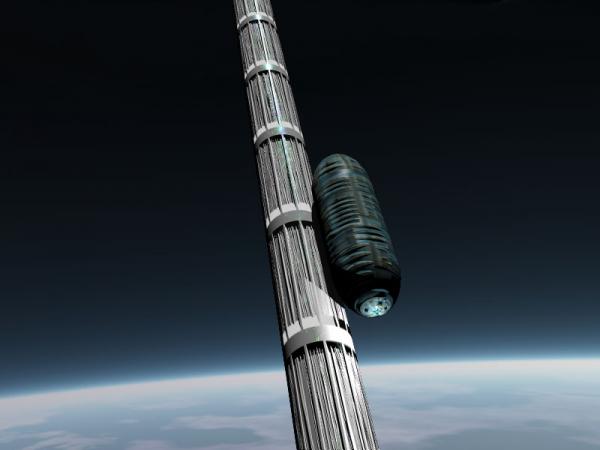BY LETTER
Beanstalk
Technology > Technology Type or Material > Drytech/Hylotech
Technology > Technology Levels > High Tech / Hitech
Technology > Application > Megascale Engineering
Technology > Technology Type or Material > Nanotech
Technology > Application > Transportation > Surface-To-Orbit Transport
Technology > Technology Levels > High Tech / Hitech
Technology > Application > Megascale Engineering
Technology > Technology Type or Material > Nanotech
Technology > Application > Transportation > Surface-To-Orbit Transport
Space Elevators; cable access to space from a planetary surface | |
 Image from Copyright Lilly Harper | |
| The far end of a space elevator is usually held taut by a counterweight of some sort, often a captured asteroid. This is known as the Anchor. | |
Assuming that the beanstalk uses conventional baryonic matter, the gravitational pull of the planet is a limiting factor. Rocky worlds only slightly more massive than Earth have too much gravity to permit the construction of a beanstalk. Similarly, if the planet rotates too slowly, the geostationary orbit is much further out, and this can also rule out the deployment of a beanstalk. So most superterrestrial worlds and tidally locked worlds cannot be accessed by a conventional space elevator. But beanstalks are commonplace on smaller worlds, especially those with moderately rapid rotation.
Beanstalks often have a counterweight at the outer end to provide tension and stability. This weight is called an Anchor or anchorweight. If the cable does not have an anchor, it may swing about in a semi-chaotic manner.
A beanstalk provides relatively simple access to space using elevators, and although climbing the beanstalk takes a long time, the payload can be accelerated using power transmitted from the ground.
Many planetary colonies have a series of beanstalks connecting the surface to geostationary orbit, and if the payload then travels past the geostationary point, it will experience an outwards acceleration; the payload can then be released to travel away from the planet at a range of speeds and directions.
Although the effect from a beanstalk breaking and whiplashing around the planet would be quite serious, this has only rarely happened. Link to early space elevators.
 Image from Anders Sandberg |
Beanstalks to Orbital Rings
A populous planetary colony will often decide to construct an orbital ring around its equator, supported by Mass-Stream Technology. Orbital rings of this kind are often constructed in a lower orbit than geostationary, and in this case the length of any beanstalks can be reduced significantly. Similarly the duration of the trip to the orbital ring is much reduced.However, once the payload has reached the orbital ring, it must be accelerated still further in order to reach locations beyond planetary orbit,
Related Articles
Appears in Topics
Development Notes
Text by M. Alan Kazlev
Updated by Steve Bowers 2024
Initially published on 08 October 2001.
Updated by Steve Bowers 2024
Initially published on 08 October 2001.
Additional Information
Image 'Space Elevator Anchor' copyright by Lilly Harper used with permission. Please contact her for conditions of re-use at https://beaconsinthedark.wordpress.com/.






